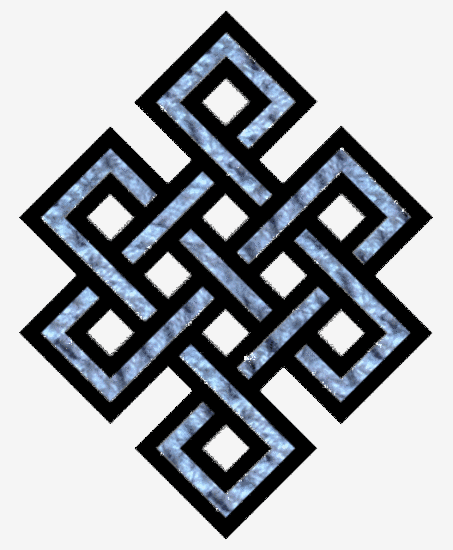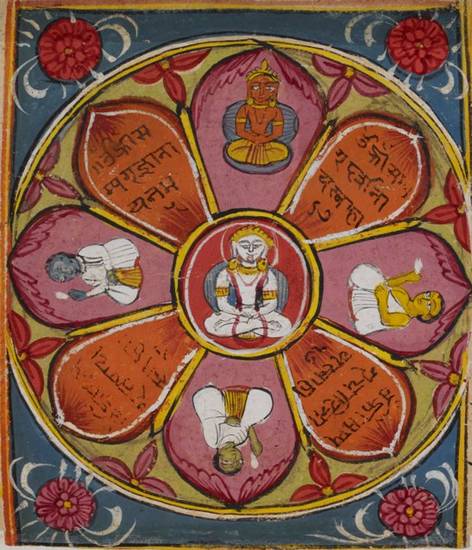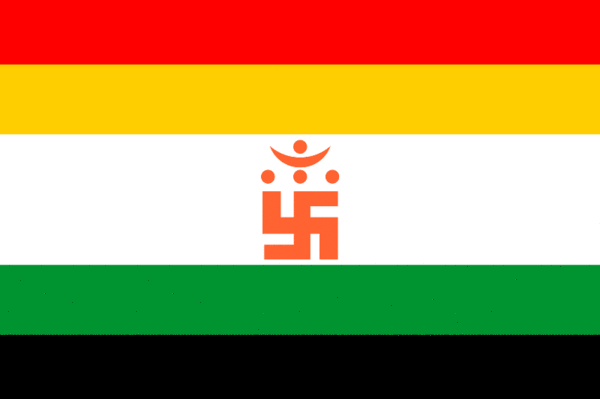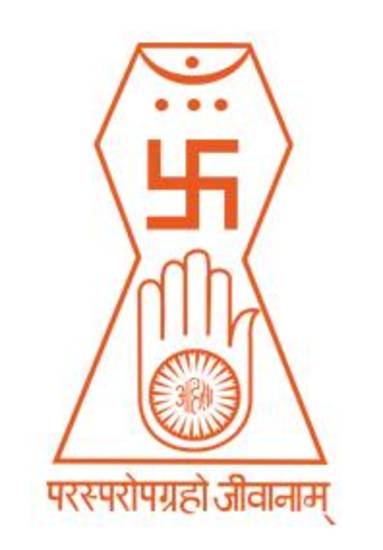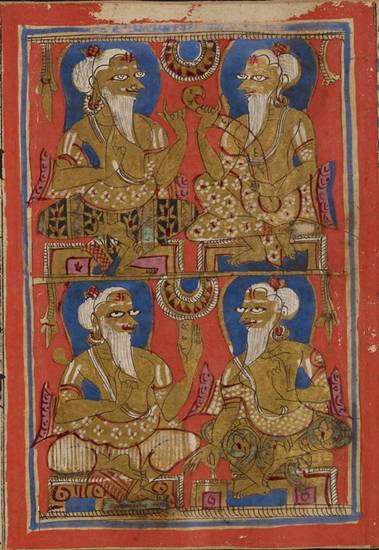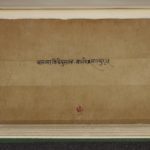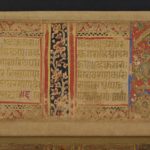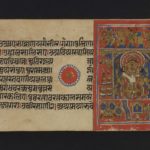Article: Holy symbols
Like all religions, the Jain faith has holy symbols that remind believers of certain principles and traditions and help create a sense of identity based on shared beliefs and practices. Some symbols are also considered auspicious, bringing good fortune and warding off bad luck. Many of these are characteristic of wider Indian culture and are therefore also found in other religions that originated in India, such as Hinduism and Buddhism.
Each of the 24 Jinas has a particular emblem, used as a badge of identity along with a colour. Other traditional Jain sacred symbols include the svastika and the siddhacakra or navapada. Some of these are grouped together as the eight auspicious symbols – aṣṭa-mangala. More recent symbols of Jainism are the Jain flag and the contemporary Jain emblem.
The importance of dreams in wider Indian culture is reflected in Jain stories and legends in which dreams play a key role. Dreams in which events or items appear are often thought to predict the future or reveal hidden facts. Stories that involve dreaming of a lost image of a Jina are often associated with sacred places, which are also pilgrimage sites.
Not all holy symbols are visual or material. Mantras are holy syllables, words, or phrases that are repeated many times, either aloud or silently. Used to focus concentration in meditation, these religious formulas are considered holy and possessed of great spiritual power. This is why mantras are found so often written, painted, carved, embroidered and so on.
The principal Jain sects of Digambaras and Śvetāmbaras differ in their lists of both the eight auspicious symbols and of the emblems of the Jinas. There are also variations in the auspicious dreams in their different versions of certain key tales, such as the dreams seen by a woman pregnant with a Jina-to-be.
The auspicious symbols and practices are frequently found in the Jain religion. Symbols may be worshipped themselves or used in religious rites. Commonly used to decorate temples, ritual objects, clothing and other valued items, they feature in art of all kinds. To Jains the image of a holy symbol takes on some of the spiritual power of the symbol itself and is thus not merely a pretty picture.
Eight auspicious symbols
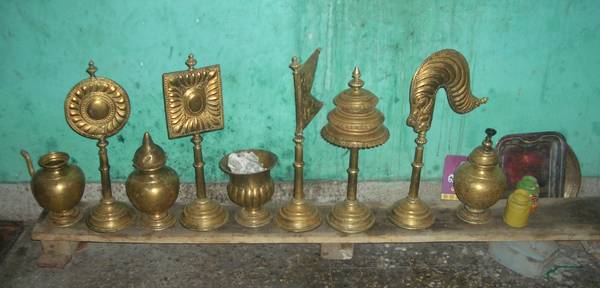
Auspicious symbols in a Digambara temple
Image by Nalini Balbir © Nalini Balbir
The aṣṭa-mangala or ‘eight auspicious symbols’ is a collection of the most auspicious and most commonly used holy symbols in Jainism. The Digambaras and Śvetāmbaras have different lists but share the overall themes. These relate primarily either to royalty and status or to wealth, abundance or fertility.
Some symbols, such as the canopy or fly-whisk, are shorthand for royalty or high status in Indian art in general. These underline that the Jina or other holy figure is a spiritual prince, as worthy of honour as a worldly prince.
|
Śvetāmbara list |
Digambara list |
|
|---|---|---|
|
1 |
gilded vase – bhṛngāra |
|
|
2 |
fly-whisk – cāmara |
|
|
3 |
banner – dhvaja |
|
|
4 |
powder box or flask – vardhamānaka |
fan – vyājana |
|
5 |
throne – bhadrāsana |
umbrella or canopy – chatra |
|
6 |
full water-jug – kalaśa |
seat of honour – supratiṣṭha |
|
7 |
pair of fish – matsyayugma |
full water-jug – kalaśa |
|
8 |
mirror – darpaṇa |
mirror – darpaṇa |
Symbols of affluence and fertility, such as the full jug or pitcher, represent the notion of growth and development. These ideas are important in Jainism because Jains must travel their paths of spiritual progress alone, each one responsible only for his or her own soul. By moving through the cycle of rebirth over hundreds and thousands of lifetimes, a soul grows gradually purer, uncluttered by karma, and can eventually attain final emancipation.
Svastika, nandyāvarta and śrīvatsa
Some of the eight auspicious symbols are also the badges of a few of the Jinas. As symbols first found in Indian civilisations going back thousands of years, these ancient icons have been widespread throughout wider Indian culture for a very long time. These symbols are thus significant in their own right and are found throughout Jain art and manuscripts as well as in temples, mendicant lodgings and so on.
The svastika or swastika is a cross with each of its four arms bent at a right angle and turned in a clockwise direction. Derived from a Sanskrit word meaning ‘well-being’ – svasti – the word itself connotes ‘good’ and ‘beneficial’. Considered highly lucky, the svastika sign has two main interpretations in Jainism. In the first, the svastika’s four arms correspond to the four possible states of existence – gati – in the world of rebirth. In the second, the arms represent the fourfold Jain community – caturvidha-sangha. The table provides details of these two readings.
|
Four gatis |
|||
|---|---|---|---|
|
heavenly being |
|||
|
infernal being |
|||
|
animal |
lay men |
||
|
human being |
The svastika is frequently depicted with three dots above, topped by a horizontal crescent above the dots. The three dots stand for the three jewels of Jainism, which are the path to liberation. The crescent represents the siddha-śilā, where liberated souls live in eternal bliss, and which Jains hope to reach eventually.
A shape like a larger, more complex version of a svastika or a labyrinth, the nandyāvarta hassimilar associations to the svastika. The Sanskrit term nandī means ‘joy, prosperity’.
The śrīvatsa is a diamond-shaped mark on the chest of the Jinas. It is often visible on sculptures or pictures of the Jinas.
Siddhacakra or navapada
The siddhacakra or navapada is the most popular yantra in Jainism. The Sanskrit word siddhacakra means ‘circle of perfection’ and is the Śvetāmbara term. The sect of the Digambaras calls the same symbol navapada.
As its name suggests, the siddhacakra has nine parts and looks like a flower with eight petals. The nine components represent the Five Entities and the Three Jewels of:
The last element symbolises a characteristic that is often dubbed the fourth jewel – ‘right austerity‘. Devout Jains must follow the examples of the Five Holy Entities and strive to practise the last four qualities. Thus all nine elements are vital to attaining liberation.
It is closely associated with the Namaskāra-mantra, which pays homage to the Five Entities. A Prakrit formula, it can be recited at any time.
The siddhacakra is found in many temples and is an important part of many rituals. It plays a central role in rites performed during the festival of Āyambil Oḷī and the associated fast.
Jain flag
The Jain flag has five horizontal bands of different colours. From top to bottom, the colours are red, yellow, white, green and dark blue, or black.
In the centre, on the white band, is a svastika, with three dots above it and a crescent at the top. The dot above the crescent represents a liberated soul. These are all in orange.
The colours used in the flag are significant. The coloured bands are the emblematic hues of the 24 Jinas and can also represent the Five Holy Entities, who are very honoured in Jainism. The colour orange is associated with one of the Five Holy Entities, namely the ācārya or head monk. Shades of orange and saffron have been linked with religion in India for millennia and orange robes are often worn in religious ceremonies by Hindus and Buddhists as well as Jains.
The origin of the flag is difficult to pin down but it has become fairly widespread since the late 20th century. It is frequently seen flying from the top of temples and is commonly paraded in the processions that are elements of Jain festivals. It could have an ancestor in the banner – dhavja – which is one of the auspicious dreams and, as such, is holy. The banner and other dreams are listed in the Śvetāmbara scripture called the Kalpa-sūtra, which is generally considered to date back to at least the 5th century CE.
Jain symbol
The Jain symbol is in the shape of the cosmic man. Inside the outline of the cosmic man is a background comprised of the five colours of the Jain flag, though the colours are not always used. Inside the shape are a svastika topped with three dots, a crescent and another dot. Below the svastika is an open hand, on the palm of which is a mantra in a wheel. The mantra is the word ahiṃsā – non-violence.
The colours that often form the symbol’s background are associated with the 24 Jinas and the Five Holy Entities. The cosmic man is the standard depiction of the three worlds of the traditional Jain universe. Resembling the shape made by a man standing with his hands on his waist, the three worlds are the environment through which Jains believe the soul passes in the cycle of birth over many thousands of years. The lower world holds the hells, the middle world is where human beings live and the upper world is the domain of the gods. At the top of the worlds is the crescent-shaped siddha-śilā, home of emancipated souls.
The sign of the svastika represents either the four modes of existence or the fourfold Jain community. The set of dots symbolises the three jewels of Jainism while the crescent represents the siddha-śilā, with a liberated soul depicted as a dot within it.
The open hand reminds believers to always stop and think before acting, specifically to obey the cardinal principle of the Jain faith – ahiṃsā. The wheel represents the cycle of rebirth, through which the soul is fated to pass until it is liberated when it reaches the highest level of spiritual purity. Someone who does harm and does not follow the principles of Jainism remains trapped in the cycle of rebirth. The 24 spokes of the wheel symbolise the teachings of the 24 Jinas, which can help believers make spiritual progress towards enlightenment and then emancipation.
At the bottom is a verse from the Tattvartha-sūtra scripture, which is often translated as ‘Souls give service to one another’.
The 2500th anniversary of the liberation of the last Jina, Mahāvīra, was celebrated in 1975. On this date the worldwide Jain community selected this emblem to represent their faith, since it incorporates several important religious symbols. Since then the symbol has enjoyed widespread currency, used both to represent the Jains to outsiders and within the Jain community. It is used in magazines, websites and community publications as well as during festivals and other community events.
Dreams
The motif of the dream features in many Jain stories and legends, usually as a way of bringing hidden knowledge to light. Dreams may foretell the future, instruct the dreamer or point to concealed religious artefacts. Revelatory or predictive dreams are common in Indian culture and dreams in Jain stories are primarily connected with the Jinas, the pivotal figures in Jain belief. Events and symbols that appear in famous dreams are frequently found in Jain literature and art of all kinds. However, the symbols and events in a dream are often hard to understand and interpreters are needed to decipher the meanings of dreams.
The best-known dreams in Jain legend are those experienced by the mothers of potential Jinas. The pregnant woman has 14 or 16 dreams that follow a strict sequence. The sect of the Digambaras believes that she has 16 while the Śvetāmbaras claim she has 14. Containing symbols that are linked with royal power, victory, power and luck in Indian culture, these auspicious dreams hint at the destiny of the embryo as a spiritual ruler. The Kalpa-sūtra, a Śvetāmbara scripture, details the dreams at some length, and has a central part in the festival of Paryuṣan. The auspicious dreams are frequently seen as carvings or paintings in temples. The mothers of other kinds of mythical individuals, namely the universal monarchs or cakravartins, Baladevas and Vāsudevas in Jain Universal History, also have a set number of similar dreams.
Another famous dream story in Jain legend relates to alms. Lay people who offer alms to monks and nuns must follow an ancient ritual and the mendicants who receive alms must also obey longstanding rules. These two sides to the ceremony, which is enacted daily all over India, are highlighted in the dream of Prince Śreyāṃsa. He was the first person to give alms correctly to the first Jina, Ṛṣabhanātha or Lord Ṛṣabha. The Jina had been fasting for over a year because no one knew how to offer alms properly to him. Śreyāṃsa dreamed that the monk would seek alms at his house and dreamed about what to offer him and the right way to do it. Thanks to this dream, Ṛṣabha was able to break his fast in the ceremony of pāraṇā. This event is commemorated in the festival of Akṣaya-tṛtīyā.
Dreams have also been key in creating or reviving pilgrimage destinations. For centuries Jains have performed journeys to holy sites, which are usually associated with events in the lives of the Jinas. In legend, a dream may have led the dreamer to found a site of pilgrimage. Periods of political and religious turmoil in Indian history often led to a site’s falling into disuse, being taken over by followers of another faith, or the hiding or removal of an idol. In many semi-legendary cases, a devotee uncovers a hidden image after dreaming that a deity or Jina has revealed its existence and location. This unearthed idol is housed in a new temple and becomes the focus of worship.
Mantras
A mantra is a sound, word or phrase that is accorded great spiritual power when recited correctly. Chanting it either silently or out loud, people usually repeat it many times, drawing out and increasing its spiritual influence. A mantra is believed to bring good fortune and keep the chanter safe.
Mantras are often an aid in meditation because chanting a holy formula helps to focus the mind of the meditator and lessen distractions.
The most common sacred formula in the Jain faith is the Namaskāra-mantra. Recited at any time, the Namaskāra-mantra is performed by all Jain sects, although some sects have slightly different versions.
Another widespread mantra is Oṃ – more properly Auṃ – which is also popular in Hinduism and Buddhism. In Jainism the letters of the word refer to significant concepts in the faith, namely:
Reciting the mantra properly involves enunciating all the letters in a single sound held for a long time.
There are many other holy syllables such as hrīṃ, klīṃ, klauṃ, which are used along with sacred diagrams or yantras. Yantras often contain mantras.
Mantras are found very frequently on clothing, temples and other buildings, signs, manuscripts and publications and all kinds of objects. Using a mantra as decoration is more than a visual design choice. The spiritual power believed to reside in these holy formulas is thought to be transferred to the item that the mantra decorates. Therefore adding a mantra to a garment is believed to protect the wearer and bring him or her good luck.
Reading
- Absent Lord: Ascetics and Kings in a Jain Ritual Culture
Lawrence A. Babb - Comparative Studies in Religion & Society series; volume 8
University of California Press; Berkeley, California, USA; 1996
- Organizing Jainism in India and England
Marcus Banks - Oxford Studies in Social and Cultural Anthropology series; volume 3
Clarendon Press; Oxford, UK; 1992
- The Story of Kālaka: Texts, History, Legends, and Miniature Paintings of the Śvetāmbara Jain Hagiographical Work, the Kālakācāryakathā
W. Norman Brown - Freer Gallery of Art – Oriental Studies series; volume 1
Freer Gallery of Art, Smithsonian Institution; Washington DC, USA; 1933
- A Descriptive and Illustrated Catalogue of Miniature Paintings of the Jaina Kalpasūtra as executed in the Early Western Indian Style
W. Norman Brown - Freer Gallery of Art – Oriental Studies series; volume 2
The Lord Baltimore Press / Smithsonian Institution; Washington DC, USA; 1934
- Jains in the World: Religious Values and Ideology in India
John E. Cort - Oxford University Press USA; New York, USA; 2001
- The Jains
Paul Dundas - Library of Religious Beliefs and Practices series; series editor John Hinnels and Ninian Smart; volume 14
Routledge Curzon Press; London, UK; 2002
- Jaina Temple Architecture in India: The Development of a Distinct Language in Space and Ritual
Julia A. B. Hegewald - Monographien zur Indischen Archäologie, Kunst und Philologie series; volume 19
Stiftung Ernst Waldschmidt, G+H Verlag; Berlin, Germany; 2009
- The Archetypal Actions of Ritual: A Theory Illustrated by the Jain Rite of Worship
Caroline Humphrey and James Laidlaw - Oxford Studies in Social and Cultural Anthropology series
Clarendon Press; Oxford, England UK; 1994
- 'The Kalpa Sûtra of Bhadrabâhu'
Bhadrabāhu - translated and edited by Hermann Jacobi
Abhandlungen für die Kunde des Morgenlandes
Deutschen Morgenländischen Gesellschaft series; series editor Otto Loth; volume VII: 1
F. A. Brockhaus; Leipzig, Saxony, Germany; 1879
- Singing to the Jinas: Jain Laywomen, Maṇḍaḷ Singing and the Negotiations of Jain Devotion
M. Whitney Kelting - Oxford University Press USA; New York, USA; 2001
- Heroic Wives: Rituals, Stories and the Virtues of Jain Wifehood
M. Whitney Kelting - Oxford University Press USA; New York, USA; 2009
- Riches and Renunciation: Religion, Economy and Society among the Jains
James Laidlaw - Oxford Studies in Social and Cultural Anthropology series
Oxford University Press; Oxford, UK; 1995
- Kalpa Sūtra of Bhadrabāhu Svāmī
Bhadrabāhu - translated by Kastur Chand Lalwani
Motilal Banarsidass; New Delhi, India; 1979
- Studies in Jaina Art
Umakant Premanand Shah - Abhinav Publications; Banaras, Uttar Pradesh, India; 1955
- Steps to Liberation: 2500 Years of Jain Art and Religion
Jan van Alphen - Etnografisch Museum Antwerpen; Antwerp, Belgium; 2000
- Historical Dictionary of Jainism
Kristi L. Wiley - Historical Dictionaries of Religions, Philosophies, and Movements series; series editor Jon Woronoff; volume 53
Scarecrow Press; Maryland, USA; 2004
- Jaina Yoga: A Survey of the Mediaeval Śrāvakācāras
Robert Williams - London Oriental series; volume XIV
Oxford University Press; London, UK; 1963
Links
- Siddhacakra
-
The siddhacakra or navapada is a flower with nine sections representing the Five Supreme Entities and the 'Four Jewels'. It is thus a visual summary of key elements of Jain belief. Often known as a navpad nowadays, the siddhacakra is a mystical yantra used in worship rites. This photo on Flickr shows a Śvetāmbara siddhacakra, with an ornately bedecked Jina in the centre.
- Explanations of Jain symbols
-
The website Namoka Tirth provides explanations for the common Jain symbols. Unexpectedly, this Digambara organisation offers the Śvetāmbara list of eight auspicious symbols.
Note that some of the website's assertions are not accepted by professional scholars because there is no indisputable historical proof. An example here is the dating of the first Jina, Ṛṣabha.
As with many Jain websites, the use of diacritics and transliterations here is inconsistent and does not meet academic standards.
- Mantram samsāram asāram
-
This 2008 YouTube video features a Digambara monk chanting the Mantram samsāram asāram, which is usually recited after the Namaskāra-mantra. The name of the mantra means The World of Rebirths has No Value. The slideshow provides the Sanskrit and transliterated phrases.
- Eight auspicious symbols
-
Pictures and brief explanations of the eight auspicious symbols according to the Svetāmbara sect are provided by the HereNow4U website. The explanations of some of the items are not necessarily the same as those given in JAINpedia and other sources.
- Parts of a siddhacakra
-
Academic K. V. Mardia has created a diagram describing the different parts of a siddhacakra or navapada. The foremost Jain yantra, the siddhacakra summarises some of the holiest elements of the Jain religion.
The Yorkshire Jain Foundation in the UK provides a downloadable and printable PDF. You will need to have Adobe Acrobat Reader on your computer to open PDF files.
- Svetāmbara Jina emblems
-
This picture from the Jeevraksha blog gives the emblems – lāñchana – of the 24 Jinas according to the Svetāmbara sect.
http://2.bp.blogspot.com/_xHZFB-N3uug/TNNW_DqmmeI/AAAAAAAAAzw/v43mxT0R1RY/s1600/jain_symbols2.jpg
- Svastika during Paryuṣaṇ
-
A svastika formed out of traditional clay lamps – dīpas in Sanskrit – is arranged on the petal-strewn floor of a temple during the festival of Paryuṣaṇ. The svastika is an ancient symbol of good luck and is frequently found in Jain temples, on religious equipment and on books, clothing and so on. The four dots among the arms of the svastika represent either the four states of existence or the parts of the fourfold community. Lasting eight days in late August or early September, Paryuṣaṇ is the most important Śvetāmbara Jain festival. This photograph on Flickr was taken in 2007.
- Elements of the Jain symbol
-
Jainworld.com describes the meaning of the different holy elements that make up the main Jain symbol.
- Siddhacakra mahāyantra
-
The Herenow4U website provides a picture of a siddhacakra or navapada mahā-yantra, the most popular yantra among contemporary Jains. This mystical diagram presents some of the main elements of Jainism. King Śrīpala and Queen Mayṇāsundarī, who are closely associated with it, are shown at the bottom demonstrating worship of the yantra.
- Temple decorated for Dīvālī
-
Jains commemorate the final liberation of the 24th Jina, Mahāvīra, in the festival of Dīvālī in late September or October. At Dīvālī, as in other festivals, statues and temples are lavishly decorated, as shown in this 2007 Flickr photograph of the Katraj temple in Pune, Maharashtra. Lights are festooned everywhere during the 'Festival of Lights', with both electric lighting and traditional clay lamps – dīpas – used. Examples of the ancient auspicious symbol of the svastika, with four dots representing the Jain community or the four states of existence, are clearly seen either side of the temple entrance.
http://www.flickr.com/photos/darvekar/1978597664/in/set-72157603105954957/
- Jain mantras
-
This 2007 animation from YouTube features a Digambara monk singing the fundamental Jain sacred formulas. The second is the Namaskāra-mantra, also called the Navkār-mantra or Namokār-mantra. A very old mantra in Prakrit, it can be sung to various melodies. It is chanted daily to the 'five types of beings worthy of worship' or Supreme Beings':
- enlightened teachers – Arhats or Jinas
- liberated souls – siddhas
- mendicant leaders – ācāryas
- teachers – upādhyāyas
- mendicants – sādhus.
Then comes a short mantra about the emptiness of the world of rebirths and the celebration of the 'four auspicious things' or 'four refuges':
- Arhat
- siddha
- monks
- law – dharma.
- Explaining the siddhacakra
-
Lay woman Heeral Shah explains the different elements of a siddhacakra mahā-yantra. Provided by the Victoria and Albert Museum in London, this video also includes a transcript.
http://www.vam.ac.uk/content/videos/p/video-painting-of-siddhachakra-yantra-heeral-shah/
- Eight auspicious symbols
-
Pictures and brief explanations of the eight auspicious symbols according to the Svetāmbara sect are provided by the HereNow4U website. The explanations of some of the items are not necessarily the same as those given in JAINpedia and other sources.
- Sacred colours
-
Acharya Shri Shushil Muni explains the sacred colours of Jainism, which are found in several holy symbols, including the siddhacakra, the Namaskāra-mantra and the Jain flag. The information is provided by the Jainism Literature Center, associated with the Faculty of Arts and Sciences at Harvard University.
http://www.fas.harvard.edu/~pluralsm/affiliates/jainism/jainedu/colorscience.htm
- Sketch of a siddhacakra
-
This sketch of a siddhacakra is found in a manuscript held in the National Gallery of Australia. The Svetāmbara yantra or mystical diagram has nine parts, representing key elements of Jain doctrine. In the centre of the stylised lotus flower is a Jina and around him on alternating petals sit the other beings that make up the five highest beings. On the petals between them are phrases representing the 'four fundamentals'.
http://artsearch.nga.gov.au/Detail-LRG.cfm?IRN=157990&View=LRG
- Anointing a Jina statue
-
A statue of a Jina is ceremonially anointed during the festival of Dīvālī, the 'Festival of Lights' which marks the new year. For Jains the main celebration at Dīvālī is the commemoration of the liberation of the 24th Jina, Mahāvīra. A ‘head-anointing ceremony’ – mastakābhiṣeka – is a rite performed for any Jain image. Sanctified fluids are poured over the head of the statue, accompanied by a mantra or hymn. The sacred bath is at the centre of all Jain image rituals and can be performed daily in the morning ceremony or during festivals and pilgrimages. This photo on Flickr was taken in Jodhpur, Rajasthan in October 2009.
- Praise of the Jinas
-
This 2010 YouTube video features a rendition of a hymn to the Jinas, sung in Gujarati. A stuti is an old prayer, usually in Prakrit or Apabhraṁśa, that can be either chanted or recited.
- +
- aAbhavya
- aAbhinandana
- aAbhiṣeka
- aĀcāra
- aĀcārāṅga-sūtra
- aĀcārya
- aAchalbhrata
- aAḍhāī-dvīpa
- aAdharma
- aAdho-loka
- aAdhyayana
- aAdvaita Vedānta
- aĀgama
- aAghātīya
- aAghātīya-karman
- aAgnibhuti
- aAgra
- aĀhāra
- aAhiṃsā
- aAhimsa Day
- aAjita
- aAjīva
- aAkampit
- aĀkāśa
- aAkbar the Great
- aAkṣaya-tṛtīyā
- aAlauddin Khalji
- aAlbert Einstein
- aAllah
- aAlms
- aĀlocanā
- aAloka-ākāśa
- aAmāri
- aAmbikā or Kūṣmāṇḍinī
- aAnagāra
- aAnanta
- aAnarthadaṇḍa
- aAnaśana
- aAnekānta-vāda
- aAṅga
- aAniconism
- aAnojjā
- aAntarāla
- aAntarāya-karma
- aAṇu
- aAṇu-vrata
- aAnukampā
- aAnuprekṣā
- aAnusvāra
- aApabhraṃśa
- aAparigraha
- aAra
- aĀrambha
- aĀrambhaja
- aĀratī
- aArdhamāgadhī Prākrit
- aArhaṃ
- aArhat
- aArśana-āvaraṇīya-karma
- aĀrta-dhyāna
- aĀryikā
- aĀryikā Jñānamati
- aĀśātanā
- aĀścarya
- aAscetic
- aAsceticism
- aAshram
- aAspiration
- aĀsrava
- aAṣṭa-maṅgala
- aAṣṭāpada
- aAstikāya
- aAstrolabe
- aAsura
- aAtheism
- aAticāra
- aAtiśayakṣetra
- aAtithisaṃvibhāgavrata
- aĀtma-vāda
- aĀtman
- aAuṃ
- aAurangzeb
- aAuspicious
- aAusterity
- aAvadhāna
- aAvadhi-jñāna
- aĀvaraṇī-yakarman
- aAvasarpiṇī
- aAvatāra
- aAvidyā
- aAxiom
- aĀyāga-paṭa
- aĀyambil
- aĀyu-karma
- aĀyurveda
- bBabur
- bBāhubali
- bBaladeva
- bBālāvabodha
- bBandha
- bBasadi
- bBazaar
- bBhadrankarvijay
- bBhagavant
- bBhaktāmara-stotra
- bBhakti
- bBhale
- bBharata
- bBhāṣā
- bBhāṣya
- bBhaṭṭāraka
- bBhāva
- bBhāva-pūjā
- bBhāvanā
- bBhavana-vāsin
- bBhavya
- bBhavyatva
- bBhaya
- bBhoga-bhūmi
- bBhogopabhoga
- bBodhi
- bBollywood
- bBrahmā
- bBrahma-deva
- bBrahmacārī
- bBrāhmaṇa
- bBraj Bhāṣā
- bBright fortnight
- bBritish Raj
- bBuddha
- bBuddhi-sagar
- bBuddhism
- bBuddhist
- cCaitya
- cCaityavāsin
- cCakravartin
- cCakreśvarī
- cCāmara
- cCandanā
- cCandragupta
- cCandraprabha
- cCanon
- cCāritra
- cCāritramohanīya-karman
- cCarũrī
- cCaste
- cCaturvidha-saṅgha
- cCaturviṃśati-stava
- cCāturyāma
- cCE
- cCelibacy
- cCha
- cChadmastha
- cChastity
- cCheda-sūtra
- cChristian
- cChristianity
- cClergy
- cCloning
- cColophon
- cCommentary
- cConch
- cConfession
- cCongregation
- cConsecration
- cCosmology
- cCremation
- cCrore
- cCult
- cCūrṇi
- dDādā-guru
- dDalit
- dDāna
- dDaṇḍa
- dDark fortnight
- dDarśana
- dDarśanamohanī-yakarman
- dDaśa-lakṣaṇa-parvan
- dDeity
- dDelhi Sultanate
- dDerāsar
- dDeśāvakāśika-vrata
- dDetachment
- dDevanāgarī
- dDevānandā
- dDevarddhi-gani
- dDevotee
- dDhamal
- dDhanuṣ
- dDhāra
- dDharma
- dDharma-dhyāna
- dDharma-sāgara
- dDharmastikaya
- dDhātakīkhaṇḍa
- dDholak
- dDhyāna
- dDiaspora
- dDig-vrata
- dDigambara
- dDīkṣā
- dDisciple
- dDīvālī
- dDivya-dhvani
- dDNA
- dDoctrine
- dDogma
- dDonor
- dDoṣa
- dDravya
- dDravya-pūjā
- dDrone
- dDuṣamā
- dDuṣamā-duṣamā
- dDuṣamā-suṣamā
- dDveṣa
- dDvīpa
- eEast India Company
- eEightfold Path
- eEkānta-vāda
- eEkendriya
- eElder
- eElders
- eEschatology
- eEtc up to
- fFarmān
- fFast
- fFatehpur Sikri
- fFestival
- fFestschrift
- fFiruz Shah
- fFly-Whisks
- fFolio
- fFour Noble Truths
- gGaccha
- gGaṇa
- gGaṇadhara
- gGanadharavada
- gGaṇeśa
- gGaṇin
- gGarba
- gGarbha
- gGarbha-gṛha
- gGaruḍa
- gGati
- gGene
- gGenomics
- gGhātī-yakarman
- gGhātīya
- gGhaznavid
- gGhiyasuddin Tughlaq
- gGhurid
- gGloss
- gGotra-karma
- gGujarāt
- gGujarati
- gGuṇa
- gGuṇa-sthāna
- gGuṇa-vrata
- gGupti
- gGuru
- gGuruṇī
- hHagiography
- hHajj
- hHaṃsa
- hHaribhadra
- hHariṇaigameṣin
- hHasta
- hHeresy
- hHiṃsā
- hHindi
- hHindu
- hHinduism
- hHīravijaya
- hHoroscope
- hHrīṃ
- hHumayun
- hHymn
- iIconoclasm
- iIconography
- iIdol
- iIndian Independence
- iIndology
- iIndra
- iIndrabhūti Gautama
- iIndriya
- iInitiation
- iIntercession
- iInvocation
- iIQ
- iIslam
- iIslamicate
- iIṣṭadevatā
- iĪśvara
- jJagat
- jJahangir
- jJain
- jJaina Devanāgarī
- jJaina Śaurasenī
- jJaina-dharma
- jJainaśāsana
- jJainness
- jJaisalmer
- jJamāli
- jJambū-dvīpa
- jJames Burgess
- jJanma
- jJanma-kalyāṇa
- jJarā
- jJāti
- jJina
- jJina-āgama
- jJina-bhavana
- jJina-bimba
- jJina-mātā
- jJinacandra-sūri
- jJinadatta
- jJinaprabha
- jJīva
- jJñāna
- jJñāna-āvaraṇīya-karma
- jJñāna-āvarṇiya
- jJñānsundar
- jJyotiṣka
- kKāla
- kKālakācārya-kathā
- kKālidāsa
- kKalpa-sūtra
- kKalpa-vṛkṣa
- kKalyāṇaka
- kKalyanvijay
- kKamaṇḍalu
- kKamaṭha
- kKarma
- kKarma-bhūmi
- kKarma-grantha
- kKarma-prakṛti
- kKarma-vāda
- kKarmon
- kKarnataka
- kKaṣāya
- kKathā
- kKāvya
- kKāya
- kKāyotsarga
- kKeśa-loca
- kKetu
- kKevala-jñāna
- kKevalin
- kKhalji
- kKharatara-gaccha
- kKnowledge
- kKriyā
- kKriyā-vāda
- kKṛṣṇa
- kKṣamā-śramaṇa
- kKṣapakaśreṇi
- kKṣatriya
- kKṣullaka
- kKulakara
- kKundakunda
- kKunthu
- lLabdhi
- lLaity
- lLakh
- lLāñchana
- lLands of Action
- lLaukāntika
- lLavaṇa-samudra
- lLeśyā
- lLiṅga
- lLinguistics
- lLoka
- lLoka-ākāśa
- lLoka-puruṣa
- lLoka-vāda
- lLotus
- lLotus lake
- mMadhya-loka
- mMahā-videha
- mMahā-vrata
- mMahābhārata
- mMahāmastakābhiṣeka
- mMāhārāṣṭra
- mMāhārāṣṭrī Prākrit
- mMahattarā Yākinī
- mMahāvīr Jayantī
- mMahāvīra
- mMakāra
- mMakkhali Gośāla
- mMalli
- mMāna-stambha
- mManaḥ-paryāya-jñāna
- mMaṇḍala
- mMaṇḍapa
- mMandit
- mMaṅgala
- mMantra
- mMantras
- mManuṣya-loka
- mMarāṭhī
- mMārgaṇā
- mMartyr
- mMarudevī
- mMaṭha
- mMati-jñāna
- mMauryaputra
- mMecca
- mMendicant lineage
- mMetarya
- mMiracle
- mMithyādṛṣṭi
- mMohandas Gandhi
- mMohanīya-karma
- mMokṣa
- mMonastic order
- mMonasticism
- mMonk
- mMonotheism
- mMosque
- mMount Meru
- mMount Sammeta
- mMṛgāvatī
- mMughal
- mMuhammad
- mMuhammad bin Tughlaq
- mMuhpattī
- mMūla-sūtra
- mMūlaguṇa
- mMumbaī
- mMuni
- mMunisuvrata
- mMurad Bakhsh
- mMūrti-pūjaka
- mMuslim
- mMysticism
- nNābhi
- nNāga-kal
- nNāgapurīya Tapā-gaccha
- nNāgarī
- nNāma-karma
- nNamaskāra-mantra
- nNami
- nNandīśvara-dvīpa
- nNandivardhana
- nNandyāvarta
- nNāraka
- nNāraki
- nNasalisation
- nNātha
- nNavrātrī
- nNaya-vāda
- nNemi
- nNidāna
- nniggaṃthāṇa vā 2
- nniggaṃtho vā 2
- nNigoda
- nNihnava
- nNikṣepa
- nNirgrantha
- nNirjarā
- nNirvāṇa
- nNiryukti
- nNiṣidhi
- nNitya
- nNiyati
- nNo-kaṣāya
- nNudity
- nNun
- oOcean of milk
- oOmniscience
- oOrdination
- ppa°
- pPadmaprabha
- pPadmāsana
- pPadmāvatī
- pPādukā
- pPalanquin
- pPalette
- pPañca-muṣṭi
- pPāṇḍava
- pPaṇḍit
- pPandit Dalsukh D. Malvania
- pPandit Sukhlalji
- pPāṇipātra
- pPāpa
- pParamātman
- pParameṣṭhin
- pPāraṇā
- pParigraha
- pPariṇāma
- pParīṣaha
- pParokṣa
- pPārśva
- pPārśvanātha
- pParyāya
- pParyuṣaṇ
- pPaṭa
- pPatan
- pPātra
- pPenance
- pPersian
- pPhala
- pPhilology
- pPicchikā
- pPilgrimage
- pPīr
- pPolymath
- pPoṣadha
- pPossession
- pPothī
- pPrabhas
- pPradakṣiṇā
- pPradeśa
- pPrākāra
- pPrakīrṇaka-sūtra
- pPrākrit
- pPramāda
- pPramukhā
- pPrati-vāsudeva
- pPratikramaṇa
- pPratimā
- pPratiṣṭhā
- pPratyākhyāna
- pPratyakṣa
- pPravacana
- pPrāyaścitta
- pPrayer
- pPre-modern
- pPreach
- pPredestination
- pProtestant
- pProvenance
- pPudgala
- pPūjā
- pPujārī
- pPukharavara-dvīpa
- pPuṇya
- pPūrva
- pPuṣkara-dvīpa
- pPuṣpadanta
- pPyre
- qQur’an
- rRāga
- rRāhu
- rRainy season
- rRajasthan
- rRajasthani
- rRājimatī
- rRajoharaṇa
- rRajput
- rRāma
- rRāmāyaṇa
- rRangoli
- rRās-garbā
- rRasa
- rRathanemi
- rRatna-traya
- rRātri-bhojana
- rRaudra-dhyāna
- rRecto
- rRelic
- rRenunciation
- rRetroflex
- rRevatī
- %Ṛg-veda
- rRite
- rRosary
- %Ṛṣabha
- %Ṛṣabhanātha
- rRupee
- sSaciyā Mātā
- sSādhu
- sSādhvī
- sSāgāra
- sSaint
- sŚaivaism
- sŚaka-saṃvat
- sSallekhanā
- sŚalya
- sSamacatuṣṭha
- sSamādhimaraṇa
- sSamaṇi
- sSāmarambha
- sSamavasaraṇa
- sSāmāyika
- sSaṃbhava
- sSamiti
- sSaṃjñā
- sSaṃkalpaja
- sSaṃsāra
- sSamudghāta
- sSaṃvara
- sSaṃvega
- sSamyak-cāritra
- sSamyak-darśana
- sSamyak-jñāna
- sSamyaktva
- sSaṃyama
- sSanctuary
- sSandalwood
- sSaṇgha
- sSanskrit
- sSant
- sŚānti
- sSapta-bhaṅgi-naya
- sSārambha
- sSarasvatī
- sSarvajña
- sSāsan-devi
- sŚāsana-devatā
- sŚāstra
- %Ṣaṭ-jīvanikāya
- sSatī
- sSatīmātā
- sSatya
- sSchism
- sScribe
- sScripture
- sSect
- sSecularism
- sŚenāī
- sSermon
- sŚeṣavatī
- sSevā
- sSeven fields of donation
- sShah Jahan
- sShantidas Jhaveri
- sShrine
- sSiddha
- sSiddha-śilā
- sSiddhacakra or Navadevatā
- sSiddhānta
- sSiddhārtha
- sSiddhi
- sSikh
- sSikhism
- sŚikṣā-vrata
- sŚīla
- sSin
- sSindh
- sŚītala
- sŚiva
- sSkandha
- sSomanatha
- sŚraddhā
- sŚramaṇa
- sŚrāvaka
- sŚrāvakācāra
- sŚrāvikā
- sŚreyāṃsa
- sŚrī
- sŚrīvatsa
- sŚruta-jñāna
- sŚruta-pañcamī
- sSthānaka-vāsin
- sSthāpanācārya
- sSthāvara
- sSthavira
- sSthiti
- sStrīmukti
- sStūpa
- sSubcontinent
- sSudarshana
- sŚuddhi
- sSudharma
- sŚūdra
- sSufism
- sSukha
- sŚukla-dhyāna
- sSulasā
- sSultan
- sSumati
- sSundarśrī
- sSupārśva
- sSūri
- sSuṣamā
- sSuṣamā-duṣamā
- sSuṣamā-suṣamā
- sSūtra
- sSuyam me ausam! Tenam bhagavaya evamakkhayam
- sSvādhyāya
- sSvāhā
- sSvastika
- sŚvetāmbara
- sŚvetāmbara Terāpanthin
- sŚvetāmbaras
- sSwan
- sSyād-vāda
- tTabla
- tTantra
- tTapā-gaccha
- tTapas
- tTāraṇ Svāmī Panth
- tTattva
- tTattvārtha-sūtra
- tTemple
- tTemple-city
- tThe Enlightenment
- tTheology
- tThree worlds
- %Ṭīkā
- tTilaka
- tTīrtha
- tTīrthaṃkaranāma-karman
- tTīrthankara
- tTransliteration
- tTrasa
- tTrasa-nāḍī
- tTriśalā
- tTriṣaṣṭi-śalākā-puruṣa-caritra
- tTti bemi
- tTughlaq
- tTunk
- uUdumbara
- uUniversal History
- uUpādhyāya
- uUpāṅga
- uUpaniṣads
- uUpāsaka
- uUpasarga
- uUpāśraya
- uŪrdhva-loka
- uUtsarpiṇī
- uUttarādhyayana-sūtra
- vVāhana
- vVaimānika
- vVairāgya
- vVaiṣṇava
- vVaiśramaṇa
- vVaiśya
- vValabhī
- vVanaspatikāya
- vVandana
- vVaṇik
- vVarṇa
- vVāsudeva
- vVāsupūjya
- vVayubhūti
- vVeda
- vVedanīya-karma
- vVegetarianism
- vVehicle
- vVernacular
- vVerso
- vVidyā
- vVidyā-devī
- vVihāra
- vVijñapti-patra
- vVikrama-saṃvat
- vVikṛti
- vVimala
- vVinaya
- vVipāka
- vVirji Vora
- vVirodhaja
- vVīrya
- vVisarga
- vViṣṇu
- vVītarāga
- vVizier
- vVotive
- vVow
- vVrata
- vVS
- vVyakta
- vVyantara
- vVyasana
- yYakṣa
- yYakṣī
- yYantra
- yYaśoda
- yYaśovijaya
- yYati
- yYātrā
- yYoga
- yYoginī
- yYojana


